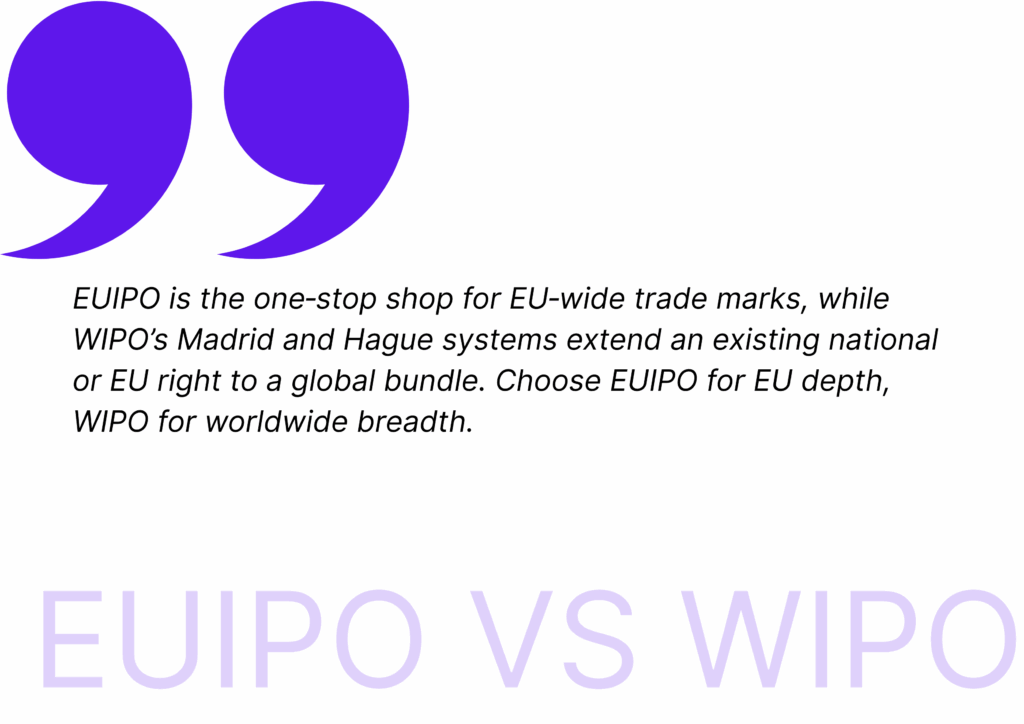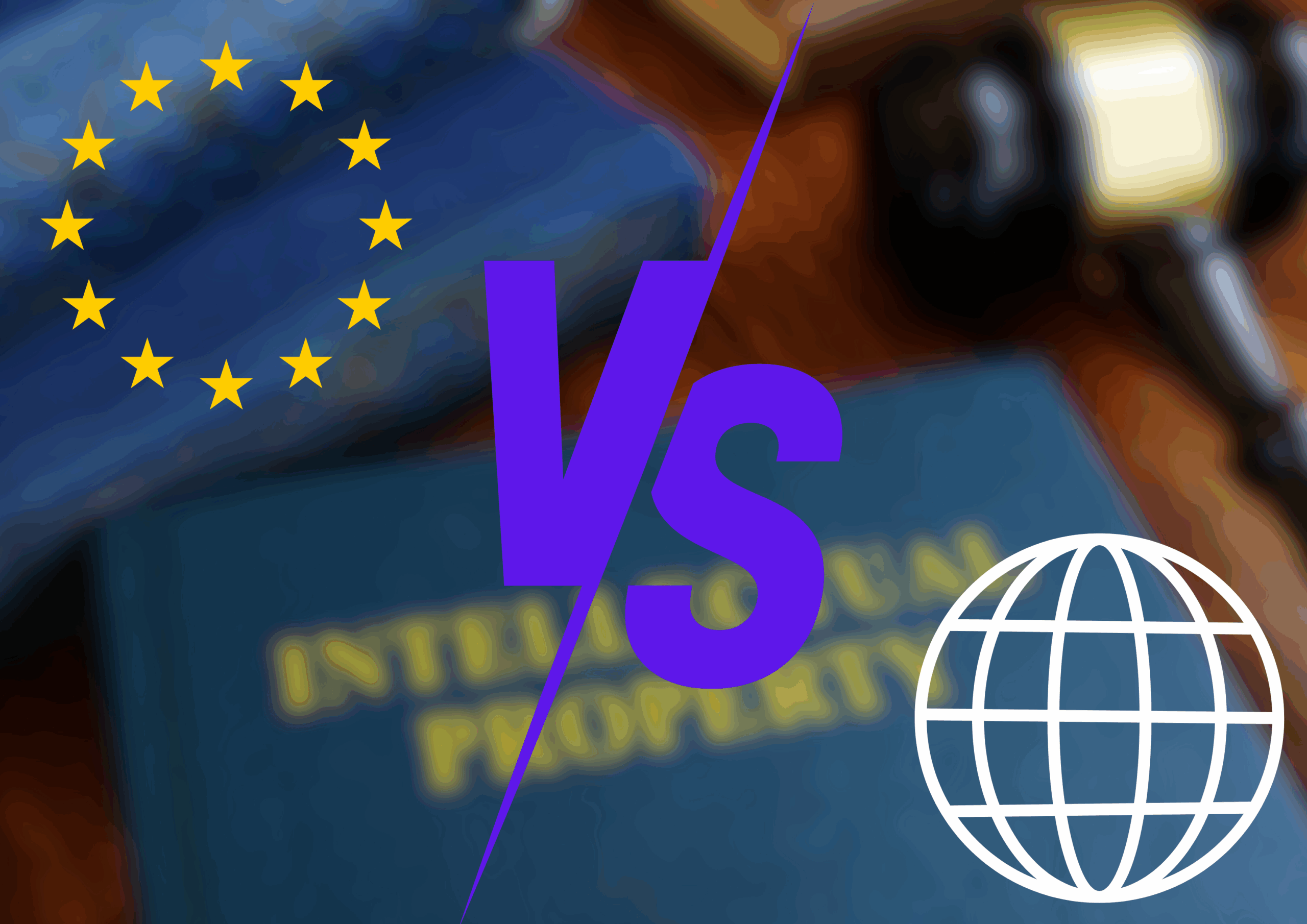Alright, firsts things first : EUIPO stands for European Union Intellectual Property Office. WIPO is for World Intellectual Property Office. EUIPO is the one‑stop shop for EU‑wide trade marks, while WIPO’s Madrid and Hague systems extend an existing national or EU right to a global bundle. Choose EUIPO for EU depth, WIPO for worldwide breadth.
jurisdiction, scope and procedure
Moreover, the headline difference in EUIPO vs WIPO lies in legal mechanics rather than geography. EUIPO is a granting authority: examiners assess absolute grounds, publish the mark, handle oppositions and, once registered, the EUTM takes effect automatically in every EU country. WIPO, by contrast, acts as an administrative postbox. It verifies formalities of an international application, collects one set of fees and then forwards the dossier to each designated office.
Those offices—be it the German DPMA, the US USPTO or Japan’s JPO—conduct substantive examination under domestic law. If none refuse within eighteen months, protection arises as if filed nationally. That subtle distinction has strategic consequences. First, centralised attack: if within the first five years the basic mark at EUIPO or a national office is cancelled, every linked Madrid registration collapses (“central attack”). Second, dependency ends after five years, giving the bundle a life of its own.
Third, enforcement: an EUTM owner can sue infringers in any EU country before one specialised court and obtain EU‑wide injunctions, whereas Madrid users must litigate country by country. According to EUIPO statistics, 165 884 EUTM applications were lodged between January and November 2024 – see EUIPO. That workload is handled by automated back‑office technology that delivers a first examination on average 2.5 months after filing. WIPO processed about 65 000 Madrid applications in 2024, slightly up on 2023’s 64 200 after two years of contraction – see WIPO.

Speed varies: Switzerland typically grants in three months, Brazil can take a year. Costs also diverge. EUIPO charges €850 for one class, €50 for the second and €150 for each extra. WIPO’s basic fee is CHF 653, but each country adds its own; designating the US alone costs CHF 451. Multiply that by ten markets and a Madrid filing soon exceeds €4 000. Yet savings kick in when more than four countries are in play because attorney charges and translation costs evaporate.
Finally, designs follow the same logic: a Registered Community Design through EUIPO covers the Union; an international design via WIPO’s Hague System extends reach to 96 parties, but individual refusals still lurk. Neither office records trade secrets—that protection rests on secrecy agreements bolstered by the 2016 EU Trade Secrets Directive. Appreciating these procedural contrasts keeps legal spend aligned with commercial reality.
cost and timing snapshot
| Item | EUIPO | WIPO (Madrid) |
| Filing fee (first class) | €850 | CHF 653 + national fees |
| Average first action | 2.5 months | 3–18 months |
| Geographic reach | 27 EU States | 129 parties |
| Appeal forum | EUIPO Boards; EU courts | National office appeals |
EUIPO vs WIPO : growth strategy and risk management
Meanwhile, entrepreneurs must overlay growth forecasts onto the legal map before choosing an office. Will next year’s revenue come primarily from Berlin, Barcelona and Bologna, or is Boise already on the roadmap? Filing an EUTM first secures every euro market now, keeps costs tight and provides the mandatory “basic mark” that can underpin a Madrid extension later. Under Madrid rules the basic mark must remain alive for five years, so the sequencing really matters. Equally, you cannot back‑date Paris priority unless the EU filing was made within the previous six months, which narrows the strategic window. Cash‑flow planning also matters. A Madrid bundle lets you stagger fees by designating only the countries you truly need, and you can add more via subsequent designations once sales justify the spend.
Remember that central attack risk cuts both ways: if an opponent cancels your EUTM because of an earlier Italian mark, the entire Madrid progeny dies too. Mitigation strategies include dividing the EU mark to carve out problematic countries, filing duplicate national marks in critical markets such as Germany, or converting a Madrid designation to a direct national application when refusals loom. Such flexibility disappears if you pick the wrong gateway at the outset. Enforcement adds yet another layer: an EUTM owner can sue once and freeze counterfeit imports at any EU border, while a Madrid registrant must chase infringers jurisdiction by jurisdiction. Still, the Madrid route becomes indispensable when your product roadmap lists at least five non‑EU targets within two years—then its cost curve plunges below the cumulative national alternative. Beyond trade marks, the same calculus applies to design and patent cooperation treaties.
Although the EPO—not EUIPO—examines European patents, WIPO’s Patent Cooperation Treaty offers a comparable single‑door filing that postpones national costs by 30 months; entrepreneurs often wrongly conflate those regimes. Keeping the acronyms straight prevents costly detours. For many SaaS firms the decisive factor is language. EUIPO accepts any of the EU’s 24 official languages, whereas WIPO restricts applicants to English, French or Spanish, potentially adding translation bills. That alone can tilt micro‑budget founders towards Alicante.
real‑world example
In short, consider the Spanish gaming start‑up “PixelToro” as a reality check. The founders launched their beta on 1 March 2024 and, on the same day, filed an EUTM for Class 9 software. Business plans projected localisation for Korea, Japan and the United States, yet investor cash would not land until quarter four. Counsel therefore advised delaying any Madrid filing until the EU registration issued, trimming the window for central attack. Registration came through on 20 August 2024—comfortably within the six‑month Paris‑priority period. Five days later PixelToro filed a Madrid application designating Japan, Korea and the US, paying CHF 1 566 in total designation fees instead of roughly €7 800 for three separate national filings. When a Korean examiner later objected that the mark translated to everyday vocabulary, the provisional refusal hit only Korea; EU and US rights remained unscathed, allowing marketing to continue.
The ability to fork protection—unitary in Europe, modular elsewhere—gave PixelToro leverage in Series A negotiations, adding a documented ten‑per‑cent valuation bump. PixelToro also bolstered enforcement: its EUTM formed the basis for a single customs Application for Action, free of charge, that now flags suspect controllers entering Rotterdam. Meanwhile, a Registered Community Design secured the console’s distinctive joystick silhouette, and a Hague filing extended that design to Mexico, where assembly will begin in 2026. The upshot is telling: comprehensive IP coverage cost less than one per cent of the seed round yet materially increased investor confidence.
On balance, the choice is not binary. Think of EUIPO and WIPO as complementary gears in the same drivetrain, each engaging at a different speed. Founders with tight budgets and Europe‑first sales gain fastest traction through an EUTM or Community Design. Once product‑market fit proves global, the Madrid or Hague routes extend that core asset without replicating paperwork. Large corporations often invert the sequence, anchoring their global portfolio on a home mark in the US or China, then designating the EU via WIPO when volumes justify the fee.
The key is disciplined decision‑making: map revenue forecasts by geography, overlay enforcement needs, pencil in cash flow, and only then press the appropriate button. EUIPO boasts a 97‑per‑cent digital filing rate and offers free mediation; WIPO, for its part, runs an arbitration centre and an online docket. Neither system will police your brand; that task still requires customs applications, marketplace take‑downs and litigation budget. But choosing the right registration platform at the outset prevents costly detours and delights investors. Ideas spark progress. Map your growth markets first, then match EUIPO or WIPO (or both) to that plan—not the other way round.
Can I use WIPO without a prior EU or national mark?
No. You must own or apply for a “basic” mark at EUIPO or a national office before filing through WIPO.
Does an EU trade secret require EUIPO or WIPO registration?
Trade secrets rely on confidentiality and the EU Trade Secrets Directive (2016/943/EU); neither office registers them.
What happens if my EUTM is opposed?
EUIPO offers cooling‑off mediation and formal proceedings; unresolved disputes can proceed to the EU General Court.



